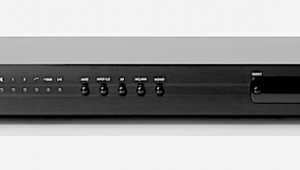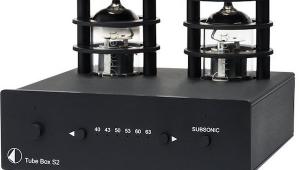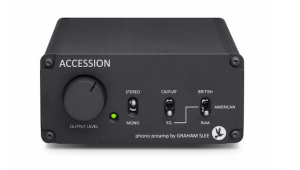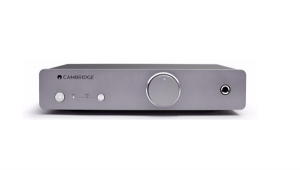Nagra VPS phono preamplifier Measurements
I measured the Nagra VPS using, for most tests, Audio Precision's top-model SYS2722 system, with some use made of the older AP System One. I used the internal jumpers to set the preamplifier to moving-magnet (MM) or moving-coil (MC) operation, and also looked at the effect of the solid-state output buffer by operating the rear-panel switch.
As used by Michael Fremer, the preamp was set to MC with the internal step-up transformers engaged and the input loading set to 1000 ohms. The input impedance measured 1024 ohms at 1kHz, dropping slightly at the frequency extremes, to 982 ohms at 20Hz and 800 ohms at 20kHz. Without any loading selected, and without the optional 47k ohm tube grid resistor engaged, the input impedance was very high, at >100k ohms. With the 47k ohm grid resistor, the input impedance was 47k ohms across the band.
With the solid-state output buffer in-circuit, the VPS's output impedance was a low 15 ohms at high and middle frequencies, this rising to 1205 ohms at 20Hz. The VPS needs to be partnered with a preamplifier having a high input impedance if the lows are not to be a little rolled off. The output of a preamplifier with an input impedance of 10k ohms, for example, will be down by around 1dB at 20Hz compared with its output at 1kHz, which might be perceived as "tighter" low frequencies. The tubed output had a low source impedance of 98.5 ohms at 20kHz, rising to 644 ohms at 1kHz and to a very high value of 7.7k ohms at 20Hz. Even more so than from the solid-state outputs, the VPS's tube outputs need to be used with a preamplifier having a suitably high input impedance, at least 50k ohms and preferably 100k ohms, if the bass is not to sound a little lean. Surprisingly, Nagra's own PL-L preamplifier, which I reviewed in June 2008, has a fairly low input impedance of 29k ohms, which will give a bass that is down nearly 2dB at 20Hz with the VPS's tube output. The darTZeel preamp used by MF has an unbalanced input impedance of 22k ohms, which will reduce the level at 20Hz by 2.3dB compared with the level at 1kHz. Fortunately, Michael used the VPS's buffered outputs, because he needed the extra gain.
Both the tube output and the solid-state buffer preserved absolute polarity. A significant difference between the two output conditions, however, concerns the preamp's overall gain. Set to MC, the gain at 1kHz from the tubed outputs was 45.2dB, 11dB of this coming from the step-up transformer. Switching the solid-state buffer in-circuit added another 16.3dB of gain, for a total of 61.5dB. In combination with the A-weighted signal/noise ratio of 61dB (ref. 500µV input at 1kHz), this will be sufficient for use with low-output MC phono cartridges. Set to MM, the gain figures were 34.1dB (tubed output) and 50.6dB (solid-state), though the A-weighted S/N ratio was not much different, at 62.6dB. (The same circuit is used for both conditions, but with the transformers engaged for MC operation.)
The Nagra's RIAA equalization can be set internally to either full-range low-frequency extension or with a 3dB rolloff at 20Hz. MF used the VPS set to full-range; the RIAA error is shown in fig.1. I was surprised to see a slight hump in the upper bass (+0.9dB at 150Hz, left channel; +1.2dB at 150Hz, right), which will be audible. However, this same error is apparent in the measurements of the VPS supplied by Nagra. (Commendably, Nagra includes a set of measured data for every sample of their products.)

Fig.1 Nagra VPS, MC/Hi setting, RIAA error (0.5dB/vertical div.).
A slight rise in the treble is accentuated above the audioband, suggesting that Nagra implements a version of the Neumann modification of the RIAA deemphasis curve, to compensate for the fact that the gain of the disc-cutting amplifier doesn't continue to rise at ultrasonic frequencies, but eventually reaches a plateau. I have some philosophical problems with the Neumann compensation—not the least of which is the fact that it will accentuate the ultrasonic content of record clicks—but manufacturers who use it, such as Hervé Delétraz of darTZeel, vigorously defend it on the grounds that the system phase response is more linear at high frequencies. The VPS's channel separation (not shown) was better than specified, at 82dB L–R and 60dB R–L, both figures measured at 1kHz.
The THD percentage was relatively uniform with frequency, but a slight rise is evident at low frequencies (fig.2). This may well be due to the effect of noise, as the spectrum of a 1kHz tone at a high level (fig.3) reveals that the only significant harmonic content present is the subjectively innocuous second harmonic, at a fairly low –66dB (0.05%). Tested with a combination of high-frequency tones at a level close to overload, the Nagra VPS produced relatively low levels of high-order intermodulation products (fig.4), though the second-order difference component at 1kHz was higher, at just above –70dB (0.03%). The rise in the noise floor around the lower of the two tones is odd. It was repeatable, however, which can't be said of the lower-frequency noise-floor modulation that can be seen in this graph. This behavior was slightly different every time I captured the spectrum.

Fig.2 Nagra VPS, MM/Hi setting, THD+N (%) vs frequency at 6mV input into 100k ohms (right channel dashed).

Fig.3 Nagra VPS, MC/Hi setting, spectrum of 1kHz sinewave, DC–10kHz, at 1mV input into 100k ohms (linear frequency scale; left channel blue, right red).

Fig.4 Nagra VPS, MC/Hi setting, HF intermodulation spectrum, DC–24kHz, 19+20kHz at 1.5V peak into 100k ohms (linear frequency scale; left channel red, right blue).
Set to MC mode, the overload margins (referenced to a typical MC output level of 500µV at 1kHz) were good rather than great, ranging from 13.73dB at 20Hz to 12.5dB at 20kHz. (These figures are equivalent to an output of around 2.65V from the buffered outputs; above that voltage, the waveform began to clip asymmetrically.) Set to MM, however, the overload margin decreased by 9dB at all frequencies, referenced to a typical MM output level of 5mV at 1kHz. MM cartridges with a "hot" output should not be used with the VPS, I feel.
As I have come to expect from Nagra, the VPS is a nicely engineered component, though it will work better when used with MC cartridges of medium to low output, I feel, than with MM types. I wonder at that slightly unflat RIAA equalization, however. I suspect that it underlies MF's finding that the VPS had a "bit of mid-bass boost" but also his feeling that the preamp's bottom octaves had "satisfying extension and weight."—John Atkinson
- Log in or register to post comments

















































